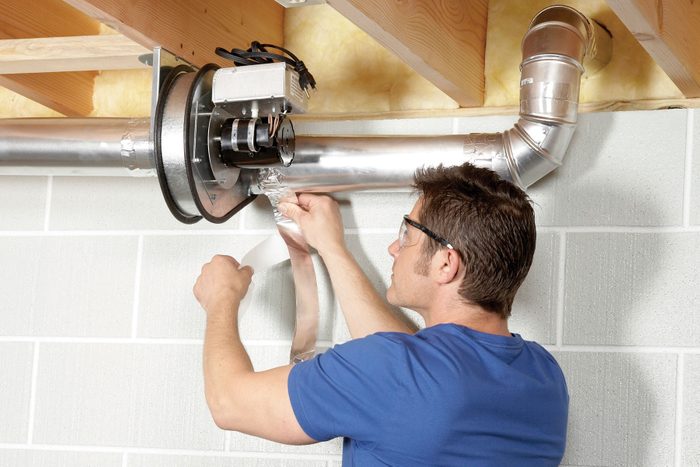What’s a Dryer Vent Booster Fan and Does It Really Work?
Updated: Mar. 22, 2024

Clothes dryers need adequate venting to do their job. If you have issues with your dryer, a dryer vent booster fan may be the answer.
Have you ever seen a dryer vent booster fan and wondered just what it’s for? Or maybe your clothes don’t seem to dry as fast as they used to, and you’re wondering if you need to invest in a booster.
We asked Kevin Busch, the president of Dryer Vent Wizard, and Josh Mitchell, an HVAC technician and founder of The Air Conditioner Lab, to share their expertise. Both dealt extensively with dryer vent systems, including the installation and maintenance.
On This Page
What Is a Dryer Vent Booster Fan?
A fan that increases the airflow in dryer vent lines. But it’s not the same as a standard duct fan.
Duct fans feature simple designs that work fine when there’s nothing but air and a little dust moving through them. But they’re quickly overwhelmed by the lint and moisture that comes through a dryer vent, creating a fire hazard.
Dryer vent boost fans handle these specific challenges safely and efficiently. Here’s an easy way to tell them apart: Dryer vent booster fans come with a larger housing and cost more.
Do Dryer Vent Booster Fans Work?
Yes. Dryer vent booster fans do an excellent job of increasing air flow. Mitchell recalls a particular installation that highlights the benefits.
“A customer had continually damp clothes and high utility bills,” he says. “Upon inspection, I found they had a vent run that extended over 40 feet with several bends.”
After installing a dryer vent booster fan, Mitchell says, things changed dramatically. “Drying times were cut in half and energy consumption dropped,” he says. “It was a textbook case of the right solution for a common problem.”
Who Needs a Dryer Vent Booster Fan?
Although these devices work, that doesn’t mean every dryer needs one.
A booster fan’s impact ultimately depends on the vent line. If you have a short run with no bends, installing a booster fan will be like running a sprinkler in a rainstorm. It still works, but you won’t notice a difference.
To determine if you need a booster fan, our experts recommend looking at the vent line itself, as well as any external signs of distress. High utility bills, clothes taking a long time to dry, and the outside of the dryer becoming unusually hot all point to an issue with the dryer vent line.
The physical design of the vent line, Busch says, can also indicate a need for a boost — things like long vent runs (more than 35 feet), vertical runs, and complex vent paths with sharp turns or multiple bends.
Hazards of a Clogged Vent Line
Both experts say you risk these issues if you don’t ensure proper airflow in your dryer vent line:
- Reduced dryer lifespan;
- Increased energy costs;
- Fire hazards.
It’s important to remember lowered airflow means lint won’t clear the vent line. Lint buildups are flammable and one of the leading causes of home fires.
How Much Does a Dryer Vent Booster Fan Cost?
Typically between $200 and $300. Safety features that distinguish them from standard duct fans drive up the cost. Additional factors that impact the price include airflow (measured in cubic feet per minute) and warranty duration.
Can You DIY Dryer Vent Booster Fan Installation?
Yes, but that doesn’t mean you should. As Busch points out, it’s “a technical and difficult job involving electrical connections and duct work.”
Mitchell agreed. “I’ve seen installations gone wrong when homeowners attempted to DIY without understanding the importance of proper placement and secure duct connections,” he says. “In one case, the improperly installed booster fan came loose, leading to massive lint buildup and a near-miss fire situation.”
How To Install a Dryer Vent Booster Fan
If you do want to install a vent booster fan yourself, you should be comfortable working with electrical lines and duct work. Read the manufacturer’s instructions carefully. You’ll need at least a drill/driver, tin snips, foil tape and dryer vent tape. You may also need to run an electrical line and open up a wall or ceiling.
Here’s how to do it:
- Cut the duct at a convenient location 10 feet or more from the dryer.
- Mount the booster fan to a ceiling joist or wall stud.
- Seal the inlet and outlet with vent tape.
- Plug the fan into an outlet.
Dryer Vent Booster Fan Maintenance
Busch recommends regularly scheduled cleaning and visual inspections to keep your booster fan running safely and efficiently. You should also periodically inspect the whole system for loose or disconnected components.
Mitchell agreed. “It’s important to verify that the booster fan is functioning every time the dryer is on,” he says. “Some models have indicator lights to show operation, which simplifies this verification. If a fan fails to operate correctly, it needs to be serviced immediately.”
About the Experts
- Kevin Busch is the president of Dryer Vent Wizard, a national home service franchise specializing in professional dryer duct and vent cleaning, inspection, repair and maintenance services. A Certified Franchise Executive through the International Franchise Association, he has more than 20 years of retail and home services operations and management experience.
- Josh Mitchell is the owner of The Air Conditioner Lab, which offers solutions to home HVAC and air conditioning issues.